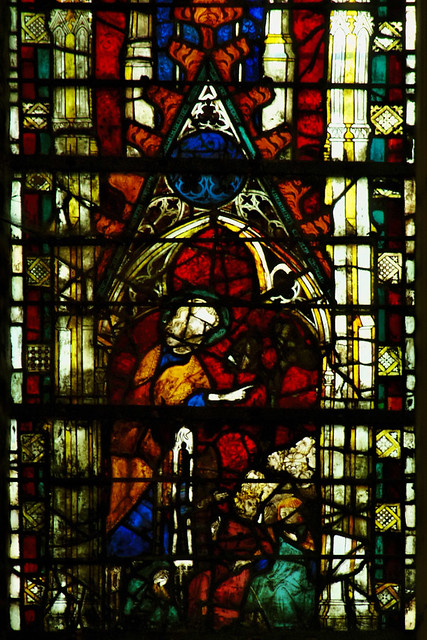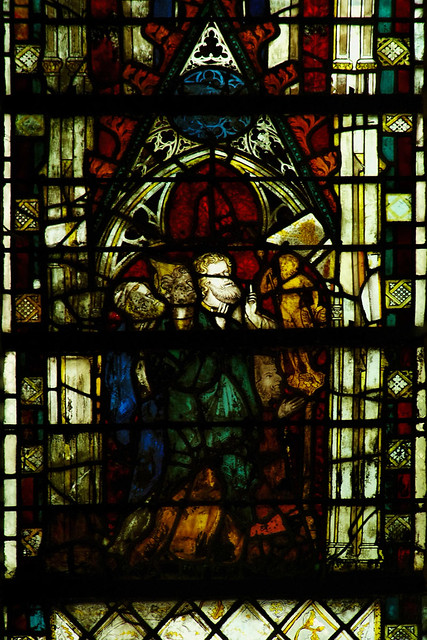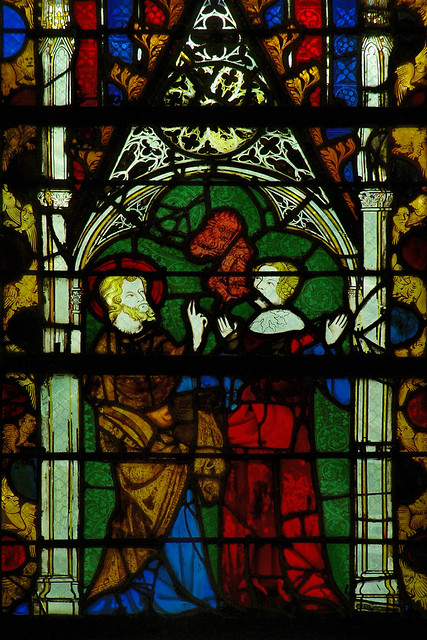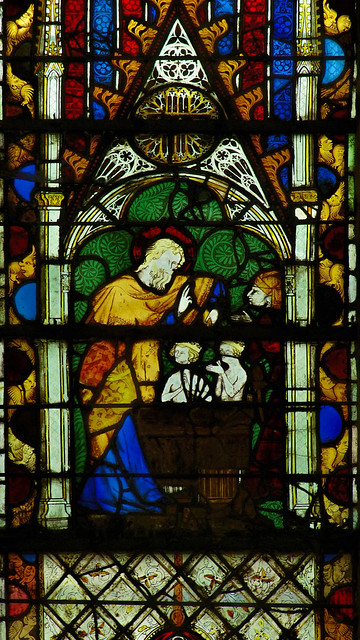The Life of St Bartholomew – St-Ouen, Rouen
The surviving panels from Baies 12 and 14 of Saint-Ouen in Rouen preserve fragments of a once extensive fourteenth-century cycle devoted to St Bartholomew, one of the Twelve Apostles and the legendary evangeliser of the East. Although the scenes are today divided between two windows and have undergone significant later restoration, they retain the expressive line, saturated colour, and elegant architectural framing characteristic of the Rouen workshops between 1325 and 1339.
Together, the panels recount the saint’s mission, miracles, and the early stages of the conflict that would ultimately lead to his martyrdom.
1. The Preaching of St Bartholomew

The cycle opens with Bartholomew as a teacher and missionary. Beneath a tall Gothic canopy with three tiers of arcading, the apostle addresses a group of listeners, courtiers or townspeople, while a local ruler observes the encounter. Bartholomew’s raised hand and calm authority indicate the beginning of his ministry in the distant land identified in medieval legend as “India” or Armenia. The damask backgrounds and parrot borders lend the scene an opulent, courtly setting, reflecting the imagined splendour of the East.
2. The Demon in the Idol Bérith

Bartholomew’s preaching quickly challenges the region’s religious practices. In the second episode, he confronts the pagan cult centred on the idol Bérith. The demon inhabiting the idol appears in the canopy above as a twisting red form, its head remade in later restoration, while a priest or dignitary gestures towards it, attempting to defend its authority. Bartholomew, with hand raised in adjuration, compels the demon to confess its deception. This dramatic moment, rendered with vivid colour and expressive gesture, illustrates the apostle’s power over the demonic and marks the collapse of the old cult.
3. The Exorcism of the King’s Daughter

The king himself soon witnesses Bartholomew’s miraculous power. His daughter, tormented by an unclean spirit, is brought before the apostle. The girl’s distress and the anxious gestures of her attendants are set against a richly patterned green background. Bartholomew stretches out his hand, casting out the demon in the same authoritative gesture seen in the confrontation with Bérith. According to the medieval Legenda Aurea, this healing leads directly to the conversion of the king and his household. The panel captures the heightened emotional charge of the scene, with the drama expressed through tightly drawn contours and animated movement.
4. The Baptism of King Polémius and His People

Following the miracle, Bartholomew baptises the newly converted. Two catechumens, stripped to the waist as was customary in medieval depictions of baptism, stand in a large tub while the apostle pours water over them. A courtier, richly dressed, looks on in solemn approval. This panel conveys the sacramental climax of the early mission: the transformation of an entire community, beginning with the royal household. The architectural canopy, rising in three levels above the scene, reinforces the dignity of the moment while situating it firmly within the Gothic visual vocabulary of St-Ouen’s glazing programme.
Conclusion
The fragments preserved in Baies 12 and 14 together evoke the narrative arc of St Bartholomew’s mission as it was imagined in fourteenth-century Normandy: his arrival, his confrontation with false worship, the demonstration of divine power through exorcism, and the conversion and baptism of a foreign king and his people.
Although the panels have been dispersed and reassembled, their surviving artistry, delicate facial modelling, luxuriant damask backgrounds, and refined silver-yellow detailing, reflects the excellence of the Rouen ateliers during one of their most productive periods. These images form a rare and compelling witness to the storytelling ambition and theological imagination of early Gothic stained glass at Saint-Ouen.
